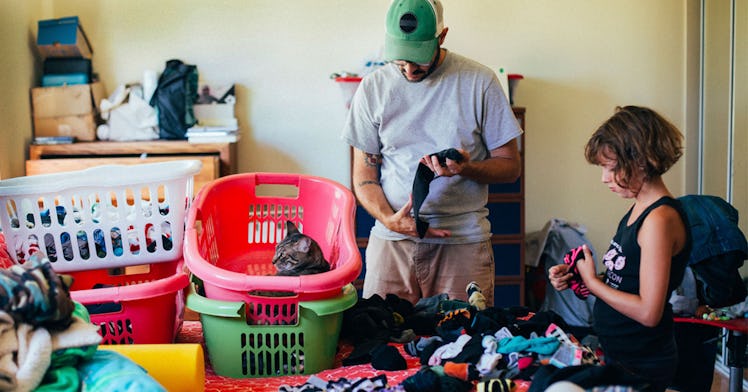Kids’ Clothes and Gear Are Expensive. The Solution? Host a Clothes Swap.
A successful kids' clothes swap planner shares tips on how to throw a successful swap.

Becoming a parent means spending a small fortune on clothes and gear that, in a matter of years or even months, kids will outgrow. That means parents are left with a bunch of stuff they can’t use and a shopping list full of replacements they need but don’t have yet. The smart, quasi-socialist solution to both sides of this problem? A used kids’ clothes swap. A swap lets parents get rid of the used kids’ clothing, toys and other gear that they don’t need anymore and stock up on new (used) gear.
Kids’ clothing swaps help parents keep their houses decluttered and save them a ton of money. They’re also good for the planet — recycling instead of tossing stuff usually is — and they can build or strengthen a sense of community among the participants.
Anyone interested in hosting a used kids’ clothing swap would be wise to listen to Susan Fox. Fox is the founder of Park Slope Parents, a community of over 5,500 families in Brooklyn, which hosts used kids’ clothes and toy swaps throughout the year. Fresh off a successful spring swap earlier this month, Fatherly asked Fox for her advice for parents who want to hold a successful swap of their own.
The Right Time and Place for a Kids’ Clothes Swap
Start your location search at churches and synagogues. Make sure you pick a space with stroller access because, as Fox puts it, “even if people don’t bring kids they many times schlep their stuff in a stroller.” A ramp is also useful for those dropping off a lot of stuff and, at the end of the meet, taking the leftovers away.
You also want to make sure that your clothes swap takes place on a weekend. Fox recommends starting as early as possible, which makes sense given how damn early kids generally wake up, even on the weekend.
How Much to Charge for a Used Kids’ Clothes Swap
“We charge $5 and it barely covers the cost of the space, insurance (many places you rent from will expect you to get insurance), volunteer goodies, sign printing, etcetera,” Fox says.
Still, she thinks it’s important to keep the price of admission low. If they don’t pay much to get it, people are more likely to feel like the expense was worth it when they leave and, therefore, more likely to come back to a future meet.
Tap Into an Existing Community of Parents and Kids
It’s possible to build a clothes swap from scratch, but it’s much easier to tap into an existing community like a Facebook parenting group for a few different reasons. First, they’re built-in networks that advertise the meet, ensuring a critical mass of attendees and items. Second, people feel accountable to communities they’re already invested in.
“In the beginning, we had non-members come and some just wanted to come and take, take, take,” Fox said. Park Slope Parents clothes swap are now open to members of the group only, and that sense of social cohesion keeps the communal spirit of the event alive.
Recruit Volunteers for Your Swap and Be Nice to Them
Volunteers are the key to a smooth swap, as planning and running a clothes swap is way too much work for one person to do. Fox is adamant about treating her volunteers well.
If you’re having trouble recruiting, she recommends enticing parents to volunteer by giving them first dibs on the stuff that comes in.
Manage Parents’ Expectations at the Clothes Swap
“We used to say, ‘Take only as much as you brought’ but older kids’ clothes are in shorter supply than 0-12 months,” Fox says. Today, “Take as much as you need” is the philosophy, a more reasonable expectation for parents exchanging goods within a community.
As they leave, Fox asks the swappers, particularly those looking for stuff for older kids, if they got one good thing. The answer is usually yes, and that means people leave feeling satisfied, not disappointed if they didn’t get as many items as they brought.
The Secret to a Successful Kids’ Clothes Swap: Organization
It’s simple: a poorly organized clothes swap is a bad clothes swap. Fox recommends round tables instead of long tables because it’s easier for people to crowd around and look at what’s on them. If possible, you should also set up the tables the night before.
Make sure the tables are well-marked so people can find things easily, and “Consider having a map of the layout when people are coming in so they have a sense where they need to go for their new stuff,” Fox says.
She also says that people should pre-sort items they drop off, which saves the volunteers from doing a lot of tedious prep work. Make sure your outreach includes a list of age-based categories so parents know how to split up the stuff they’re bringing to the meet.
This article was originally published on